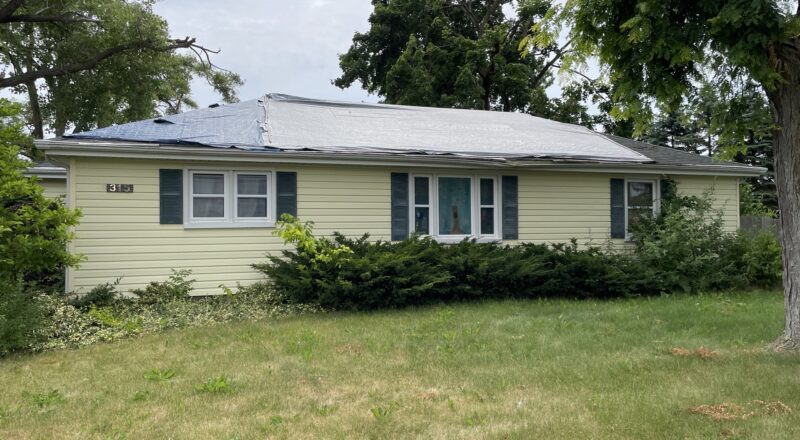Introduction:
When a hailstorm hits, it can wreak havoc on your roof, causing damage that may not always be immediately visible. Roof hail damage can lead to costly repairs if left unattended. Therefore, it’s essential to know how to identify potential damage so you can address it promptly. In this article, we’ll outline six simple steps to help you recognize roof hail damage and protect your home from further issues.
Step 1: Safety First.
Before you begin inspecting your roof for hail damage, ensure your safety. Wait until the storm has completely passed, and it’s safe to go outside. Always use a sturdy ladder and wear appropriate safety gear, including a hard hat and non-slip shoes. If you’re uncomfortable with heights or unsure about safety, consider hiring a professional roofing inspector.
Step 2: Check for Roof Hail Damage Indicators
Inspect Gutters and Downspouts: Start by examining your gutters and downspouts. Look for dents, cracks, or chipped paint on these metal surfaces. Hailstones can leave visible marks on these areas, which can serve as an initial indicator of roof damage.
Examine Roof Vents and Accessories: Inspect the vents, furnace chimneys, and other roof accessories for signs of damage. Hail can cause cracks or pockmarks on these structures. Any visible damage may suggest that your roof has been affected as well.
Look for Missing Shingles: Hail is usually accompanied by high winds, it can dislodge or break shingles. Check for missing or damaged shingles on your roof. Look for exposed or torn underlayment, as this can be an indication of hail damage beneath the shingles.
Step 3: Check the Attic
After examining the exterior, it’s time to head to the attic:
Check for Water Stains: Inspect your attic ceiling for water stains or discoloration. These stains may indicate that water is seeping through damaged areas on the roof. If you find any, it’s a sign of a leak that needs immediate attention.
Inspect Insulation: Look at your insulation material for moisture. Wet or damp insulation can be a clear sign that your roof has sustained damage and is allowing water to infiltrate.
Step 4: Assess Roofing Material
Carefully examine the roofing material itself:
Check for Bruising: Walk around your roof and inspect the shingles or roofing material closely. Hail can create small dents or “bruises” on the shingle surface. These bruises may not be immediately noticeable but can lead to roof deterioration over time.
Examine Shingle Granules: Hail damage can dislodge the granules on asphalt shingles. Check your gutters and downspouts for an accumulation of granules, as this is a sign that your shingles have been compromised.
Step 5: Document the Hail Damage
If you find any evidence of roof hail damage, it’s crucial to document it for insurance purposes:
Take Photos: Use a camera or smartphone to take clear photos of the damage. Capture close-up shots of affected areas and wider shots to provide context.
Contact Your Insurance Company: Reach out to your homeowner’s insurance company to report the damage. Provide them with the documentation you’ve collected, as this will aid in the claims process.
Step 6: Contact a Trusted Local Roofer
If you’ve discovered any signs of hail damage on your roof or if you’re unsure about the extent of the damage, it’s imperative to reach out to a reputable local roofer. Here’s why:
Comprehensive Evaluation: A professional roofer will conduct a comprehensive evaluation of your roof, both visible and hidden areas. They’ll not only identify current damage but also assess potential vulnerabilities that could lead to future issues. This thorough examination ensures that all problems are addressed, safeguarding your home in the long run.
Insurance Assistance: Dealing with insurance claims for hail damage can be a complex process. Local roofers often have experience working with insurance companies and can assist you in navigating the claims process. They can provide documentation, estimates, and expert opinions to support your case.
Customized Solutions: Roofing professionals will provide tailored solutions based on the specific needs of your roof. Whether it’s repairing damaged shingles, addressing structural issues, or recommending preventive measures, they’ll develop a plan that suits your home’s unique requirements.
Quality Roof Repairs: Local roofers have a vested interest in maintaining their reputation within the community. They are more likely to deliver high-quality workmanship, using the right materials and techniques to ensure that your roof is restored to its optimal condition.
Conclusion
Identifying roof hail damage is a crucial step in maintaining the integrity of your home and preventing further issues. By following these six simple steps and promptly addressing any damage, you can ensure that your roof remains in good condition. Remember that safety should always be your top priority, so exercise caution when inspecting your roof or consider hiring a professional if needed.
